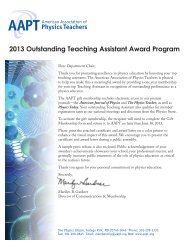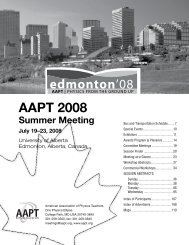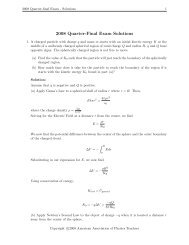Solution - American Association of Physics Teachers
Solution - American Association of Physics Teachers
Solution - American Association of Physics Teachers
Create successful ePaper yourself
Turn your PDF publications into a flip-book with our unique Google optimized e-Paper software.
2013 F = ma Exam 1416. Inspired by a problem from the 2012 International <strong>Physics</strong> Olympiad, Estonia.A very large number <strong>of</strong> small particles forms a spherical cloud. Initially they are at rest, have uniform mass densityper unit volume ρ 0 , and occupy a region <strong>of</strong> radius r 0 . The cloud collapses due to gravitation; the particles do notinteract with each other in any other way.√3πHow much time passes until the cloud collapses fully? (The constant 0.5427 is actually32 .)(A)0.5427r 02 √ Gρ 0(B)0.5427r 0√ Gρ0(C)0.5427√ r0√ Gρ0(D) 0.5427 √ Gρ0(E) 0.5427 √ Gρ0r 0<strong>Solution</strong>This problem is a matter <strong>of</strong> dimensional analysis. All <strong>of</strong> the answers have the formt = 0.527G −1/2 ρ −1/20 r 0nThe dimensions <strong>of</strong> t are [T ], the dimensions <strong>of</strong> G are [L] 3 [M] −1 [T ] −2 , the dimensions <strong>of</strong> ρ 0 are [L] −3 [M], andthe dimensions <strong>of</strong> r 0 are [L]. So[T ] = ([L] 3 [M] −1 [T ] −2 ) −1/2 ([L] −3 [M]) −1/2 [L] n[T ] = [T ][L] nn = 0The time to collapse does not depend on the size <strong>of</strong> the cloud at all!Copyright c○2013 <strong>American</strong> <strong>Association</strong> <strong>of</strong> <strong>Physics</strong> <strong>Teachers</strong>
















